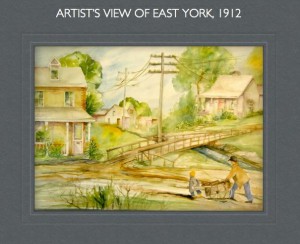What is the History of the Church of the Resurrection?

“Daisy Hill” (Amroth)
by Marilyn Pike
The First Building
The Church of the Resurrection began as a church plant (a new church made of members of another church) of St. John’s of Norway (Anglican), at Woodbine and Kingston Road. There weren’t many homes here at that time, just mostly fields.
In the summer of 1912, people began meeting in a tent at the corner of what is now Woodbine and Danforth. When the wind blew that tent over, the growing throng built their first church on Woodbine opposite Glebeholme. They eventually laid the foundation for The Church of the Resurrection in its present location in 1922. They bought the adjoining property (which is now the playground to the north of the church) hoping to expand the building, but their hopes were cut short by the Depression of the 1930s.
The Choir in 1928
During the Second World War, members of this church served in many ways. Many current members still remember dear friends and family members who fought in the war — their names are listed on the Honour Roll hanging on the north side of the church.
Golden Anniversary
1912 – 1962
During the 1940s and 50s the neighbourhood expanded considerably, as a housing boom swept through the area. The church had three services per Sunday, with 700 attending, not including the packed Sunday School in the afternoon. Even though the church could seat some 350 at one time, many still remember setting out extra chairs for the overflow. There were so many children attending the Sunday School on Sunday afternoons that we bought from Rogers Memorial Presbyterian Church (which dissolved in February 2000) their Parish Hall and moved it to the west of the church in the 1960s to house the children’s program.
The Present Era
With the 1970s, 80s, and 90s, there came a general decline in mainline church attendance all across North America. Some have come to call this “the end of Christendom.” The Church of the Resurrection was gradually affected: people didn’t necessarily lose their desire for God or spiritual things, but lost affection for institutional churches as a way to facilitate the kind of searching they sought. Reflecting that trend, our church slowly declined in membership. Tragedies and the normal sorts of conflict that can affect any human community also had their toll on our membership. By 1999, we had fallen to under 57 people on a Sunday. The Diocese of Toronto challenges churches under 60 to ask whether their ministry is viable. In some cases churches that small will call a pastor to only part-time ministry, or they amalgamate (join) with another church. However those who remained were faithfully persistent, continuing to hope and pray for a revival — a fresh infusion of life given by God.
When it came time to choose a new leader, the people at The Church of the Resurrection were presented with a vision that matched their own dreams. The Rev. Chris King of Little Trinity Church had seen small churches in England turned around by an infusion of new people from larger churches. That vision spread to Rev. Duke Vipperman who let his name stand as a candidate for The Church of the Resurrection on condition that some people from Little Trinity might be welcome to come with him. After much prayer, the Parish Selection Committee unanimously felt God calling Duke to lead us into the future. Little did anyone know God’s marvelous plans for us all!
The “First Resurrection People” as Duke calls them, those who were here first, waited with eager anticipation for the “January arrivals.” On January 23, 2000, Duke arrived with 60 adventurous people from Little Trinity and about a dozen more from other churches. This was the Church of the Resurrection’s second birth as a church plant. And we affectionately nick-named the church The Rez. Read the interview with Rev. Duke Vipperman about The Story of the Resurrection of The Rez: a reboot that worked.
Now others have heard about the new thing God is doing here and are coming to see for themselves.
Each Sunday, a combined 212 people on average are drawn to praise and worship with us. Many people who live in this neighbourhood still hold deep Christian religious values, but do not attend church. Some have had negative experiences in churches that have caused them to feel guilt, tension, or pressure. We hope that God will provide for us all a refreshment through worship that is even better than sleeping in (!), the freedom to express who we are, and an experience of God’s delight. Because we know we are forgiven by God and are set free by the cross of Christ in our relationship with Jesus, we aim to be a ‘guilt-free church.’ By that we mean, that we want people to participate in giving of time, money, and resources out of their passionate love for God and because they want to, not out of any sense of constraint or pressure.
We look forward to our future, knowing Christ and making Him known in this community.
Want to find out more about our neighbourhood and its history, including lots of cool old pictures? Here’s a detailed account put together for our 100th Anniversary year – 2012!

